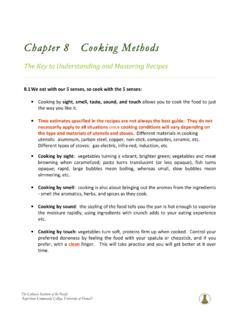Transcription of GELATIN 'CELL' DIFFUSION - IMSS Biology 2014
1 GELATIN "CELL" DIFFUSION Sizes of cells vary greatly, depending on whether they are prokaryotic or eukaryotic, and also by cell type (some neurons are a meter long!). No matter what its size, materials must be transported in and out of cells , and larger cells have developed structures to facilitate transport. This activity guides students into discovering why large cells require extra help in materials transport. Materials Stiff GELATIN , such as "Knox Blox" or dessert GELATIN made with 25% less water pH indicator --- phenolphthalein or bromthymol blue (btb) or cabbage juice* plastic or glass beakers or dishes to immerse GELATIN blocks plastic spoons knives for cutting GELATIN rulers ammonia, diluted 1:20 (100 ml ammonia into 1900 ml water) vinegar, diluted 1:4 in water (100 ml vinegar plus 300 ml water) bowl of water white paper or plate Preparation Make GELATIN as per package instructions, adding boiling water to GELATIN in a large bowl.
2 For Knox Blox the recipe is one 7 g package of GELATIN to one cup boiling water. Make enough GELATIN to fill the required number of glass dishes or loaf plans to provide enough material for your class(es). For cabbage juice indicator, chop and boil a red cabbage for 10 minutes or more. Strain out the cabbage and keep the (purple) water. Use this water to make the GELATIN . **I like to use 1g agar agar for 100ml water for a stiffer gel. Mix and microwave until dissolved. Keep your eye on it, since it overflows easily! (JY) Before pouring the GELATIN in a pan add the indicator, several millilters of phenolphthalein (in 95% alcohol) or btb. Adjust to desired color. For pink phenolphthalein GELATIN , add drops of ammonia until desired color is obtained.
3 For btb, a green color is desirable. Slowly add drops of ammonia (if your GELATIN is yellow) or vinegar (if your GELATIN is blue) and mix well until desired color is obtained. You can make blue, green or yellow cabbage juice GELATIN by adding a few drops of ammonia. Pour GELATIN in pans, cover, and refrigerate overnight. Karen E. Kalumuck Exploratorium Teacher Institute To Do and Notice Choose which type of agar you would like to try. Cut 4 blocks of each of 3 sizes of GELATIN (12 blocks total) of the following sizes: 1 cm3, 2 cm3, 3 cm3 Place 3 of each size block into a container. Cover with an appropriate substance, or cut twice the number of blocks and put half in ammonia, half in vinegar. Make sure that the blocks are covered with fluid.
4 Leave one block of each size outside of the treatment, to use as your control (comparison, untreated) blocks. At select intervals (5 minutes, 20 minutes, 45 minutes see below) remove one block of each size from the treatment (use a spoon). Dip briefly in water. Place on white paper or plate, and cut in half with knife. Observe any color changes. Measure the distance the color change has penetrated from the exterior toward the interior. Use this number to estimate the percentage of the block that the treatment has penetrated. TIME = 5 minutes Treatment: cube dimension surface volume ratio %penetrated area (cm2) cm3 surface area volume 1 cm 2cm 3 cm observations: TIME = 20 minutes Treatment: cube dimension surface volume ratio %penetrated area (cm2) cm3 surface area Karen E.
5 Kalumuck Exploratorium Teacher Institute volume 1 cm 2cm 3 cm observations: TIME = 45 minutes Treatment: cube dimension surface volume ratio %penetrated area (cm2) cm3 surface area volume 1 cm 2cm 3 cm observations: What's Going On? color change The treatment will diffuse into the blocks at a constant rate. Depending on the pH indicator in the GELATIN , a color change may or may not occur. Each pH indicator has a specific color at a particular pH. Some of the values are as follows: phenolphthalein: colorless below pH (approx.) 8, bright pink at pH 8 - , darker pink at pH10 and above; bromthymol blue: yellow pH 6 and below; green between (approx.)pH and 7, blue at pH 7 and above Karen E.
6 Kalumuck Exploratorium Teacher Institute cabbage juice --- a wide range of colors on a continuum, ranging from red (pH 2 and below) shades of pink between pH 2 and , light to dark purple between pH and ; blue between and 8; aqua at pH 9, green at pH 10 - 12, and yellow at pH 12 and higher Pink phenolphthalein in ammonia --- no visible change; in vinegar turns colorless Green btb in ammonia - turns blue; in vinegar, turns yellow Red/purple cabbage juice in ammonia -- turns green/yellow; in vinegar, difficult to discern change. Note: Your students may also note that the treatment fluid has turned color. Indicators will also diffuse out of the GELATIN into the treatment, and will turn color based on the pH of the treatment fluid. size matters At five minutes, DIFFUSION of the treatment fluid into the each size of GELATIN cube is often around 10 percent of the total volume.
7 At twenty minutes the 1mm cubes may be 100% saturated with treatment, and the other blocks less so with the 3 mm cube having a smaller percentage saturated. At 45 minutes, typical results are 60% saturation for the 2 mm cube, and 30% for the 3 mm cube. Anything that a cell takes in, such as oxygen and food, or goes out, such as wastes, must travel across the cell membrane. As cells grow larger, the ratio of surface area to volume decreases dramatically (see table below). The larger cell still must perform all the vital transportation of materials across membranes, but has a much larger volume and relatively small surface area with membrane to do so. For example, a larger cell needs more food to support its larger volume, but has less surface area - proportionately - do conduct these transactions.
8 Bacterial cells are fairly small and have a large surface area/volume ratio. Eukaryotic cells , like those of animals and plants are much larger, but have additional structures to help them conduct the amount of transport across membranes required. A series of internal membrane-bound structures that are continuous with the plasma membrane, such as the endoplasmic reticulum, provide additional surface area internal to the cell, allowing sufficient transport to occur. Even so, there are upper limits to cell sizes. This activity nicely illustrates the principles of surface area/volume ratios, and provides food for thought about cell sizes and processes. cube dimension surface* volume ** ratio Karen E. Kalumuck Exploratorium Teacher Institute Karen E.
9 Kalumuck Exploratorium Teacher Institute area (cm2) cm3 surface area volume 1 cm 6 cm2 1 cm3 6 2cm 24 cm2 8 cm3 3 3 cm 54 cm2 27 cm3 2 * surface area = number of sides times width times length ** volume = length x width x height Tidbits A small bacterium, such as Escherichia coli, a common inhabitant of our intestinal tract, measures about 2 micrometers across ( mm). The smallest organism considered an actual cell is the bacterium called a "mycoplasm". It lacks a cell wall and measures about - micrometers.
10 Some human cell sizes: Liver cell - 20 micrometers; red blood cell, 20 micrometers; mitochondria inside of a cell - 1 micrometer x 2 micrometers. A Paramecium is a very large cell at about 200 micrometers ( mm) long.








